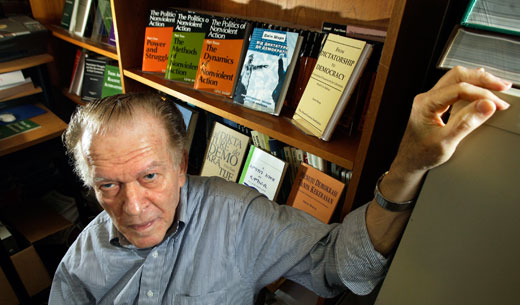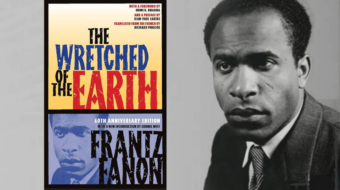
Book Review
“From Dictatorship to Democracy. A Conceptual Framework for Liberation”
By Gene Sharp
Albert Einstein Institute, East Boston, MA 02128. Available for download in 26 languages from www.aeinstein.org. Originally published 1993 in Bangkok. Fourth English Edition, May 2010. 93 pages.
I first heard of Gene Sharp from a commentator on National Public Radio. He said that he had examined the “Arab Spring” upsurges in Tunisia, Egypt, Syria, Libya and Yemen. As he found great similarities, he investigated for some sort of conspiracy between the protesters in different nations, but found, instead, “There was no conspiracy. Rather, they had all read the same book!”
The book, or rather, pamphlet, was “From Dictatorship to Democracy.” Major articles in influential newspapers credit the author with an important role in overthrowing repressive regimes.
In an article titled “Shy U.S. Intellectual Created Playbook Used in a Revolution” in the Feb. 16 New York Times, reporter Sheryl Gay Stolberg wrote, “Few Americans have heard of Mr. Sharp. But for decades, his practical writings on nonviolent revolution … have inspired dissidents around the world, including in Burma, Bosnia, Estonia and Zimbabwe, and now Tunisia and Egypt.”
An article in the December issue of Foreign Policy magazine says Sharp, “an 83-year-old Boston-based academic, was not on the ground in Tunis or Cairo, but his tactics certainly were. For more than half a century, Sharp has been working to turn the philosophies of nonviolent protest devised by Henry David Thoreau and Mohandas Gandhi into a blueprint that can be put into practice by activists around the world.”
True to its reputation, Sharp’s world-popular little pamphlet is a handbook for rebellion against repressive regimes. It has a great many general observations that ring true. Sharp’s term for a successful approach is “political defiance.” He argues positively for nonviolent resistance as opposed to alternatives such as violent revolution, simple negotiations, and foreign intervention.
Unlike some pacifists, Sharp is no fetishist about nonviolence. He simply makes a compelling argument that it is the most likely approach to bring success. Further, Sharp says implementing a broad, open and democratic movement of political defiance is far more likely to result in democracy after the overthrow of the regime, whereas other forms of overthrow risk substituting a new dictatorship for the old one. The mass movement he recommends is more than a purposeful effort to overthrow a regime. It is also the training ground for self-governance.
Not everything in the pamphlet is generalized. Gene Sharp can be quite specific. Appendix One lists 198 forms of nonviolent struggle, from “teach-ins” to “rude gestures.”
There is a great deal to learn and to think about in Sharp’s handbook, but it has deficiencies, too. One of them is an oversimplification of “democracy” and “freedom.” Sharp seems to think that anti-capitalist governments are no better than others. He doesn’t seem to be aware of imperialism as a force in the world. The Bolsheviks are exactly the same as the Ayatollahs in his view. The overthrow of Poland’s socialist government in the 1980s, in Sharp’s version, was accomplished internally with no encouragement or help from the Pope, the CIA, or the Reagan administration.
When people are asked to fight and die for freedom and democracy, it would seem only fair to warn them that imperialism will continue to strive to enslave us all.
Photo: Gene Sharp at his office in Boston with some of his books. (Elise Amendola/AP)









